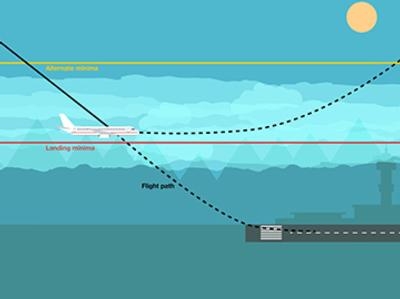First In A Series Of Planned ATSB Reports Covering Airport Operations
New ground-breaking research released by the ATSB is expected to double the chances of aircraft landing safely during times of unforecast weather. This is the first report in a series covering Australian airports supporting regular passenger transport operations.

The ATSB investigator leading the research project, Dave Wilson, has analyzed an enormous amount of weather and aerodrome data to identify weather-related safety risks for Adelaide and Mildura airports. Wilson said there were around 50,000 arrivals at Adelaide each year. The likelihood of encountering unforecast weather and having to adopt a contingency plan, such as diverting, was a rare occurrence—about one in 3000.
By developing sophisticated algorithms from the data, the research makes arrival without sufficient warning even rarer—perhaps as low as one in 10,000. In so doing, the predictive nature of the research means enhanced safety for the travelling public in Australia. “By reducing the number of aircraft being caught out, we significantly reduce the chance that something will go wrong,” Wilson said.
“As an example, if you take mornings in Adelaide, retrieving a forecast an hour out from landing could double the chance of a safe arrival compared to three hours out,. Every year there are circumstances where forecasts don’t provide sufficient warning for pilots. This means they have to divert or, in some rare cases, land below specified limits with critically low fuel levels.”
This occurred in 2013 when two Boeing 737-800 aircraft were forced to divert to Mildura from landing at Adelaide, where poor weather was also encountered. One of these aircraft landed below the specified safe limits with limited fuel remaining.
The research will benefit all aviation operators but, purely due to the number of flights, will be more useful for high capacity commercial transport. Operators will be able to use the research to help guide operational staff such as dispatchers, who support their pilots by helping to focus attention on high risk times of day and seasons of the year. It will also be of strategic use to the Civil Aviation Safety Authority, Airservices Australia and the Bureau of Meteorology. “We can identify high-risk locations and high-risk times of day and year, and when this is used with flight planning and operational rules for landing, safety can be enhanced. It will also allow for better decision-making with respect to the prioritisation of investment decisions about aircraft and aerodrome navigational equipment,” Wilson said.
This research is tangible evidence of the direction in which ATSB Chief Commissioner Greg Hood wants to take the organization. “The ATSB is committed to becoming a data-driven, predictive transport safety investigator,” Mr Hood said. “We will continue to source data nationally on aviation transport safety occurrences and events and use that data to identify and communicate safety risks and emerging trends.”
Over the next two years Wilson will expand his research and evaluate billions of rows of data to produce a series of reports documenting weather-related safety risks for regions around Australia. The research ultimately has the potential to be applied not only in Australia, but around the world.
(Image provided with ATSB news release)
 ANN's Daily Aero-Linx (05.02.24)
ANN's Daily Aero-Linx (05.02.24) ANN's Daily Aero-Term (05.02.24): Touchdown Zone Lighting
ANN's Daily Aero-Term (05.02.24): Touchdown Zone Lighting Aero-News: Quote of the Day (05.02.24)
Aero-News: Quote of the Day (05.02.24) ANN FAQ: Contributing To Aero-TV
ANN FAQ: Contributing To Aero-TV NTSB Final Report: Cirrus Design Corp SR20
NTSB Final Report: Cirrus Design Corp SR20



